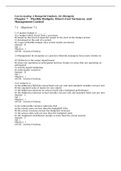Cost Accounting: A Managerial Emphasis, 16e (Horngren)
Chapter 7 Flexible Budgets, Direct-Cost Variances, and
Management Control
7.1 Objective 7.1
1) A master budget is ________.
A) a budget which starts from a zero base
B) based on the level of expected output at the start of the budget period
C) developed at the end of a period
D) a type of flexible budget once actual results are known
Answer: B
Diff: 1
Objective: 1
AACSB: Analytical thinking
2) Management by exception is a practice whereby managers focus more closely on
________.
A) variances in the larger departments
B) areas not operating as anticipated and less closely on areas that are operating as
anticipated
C) activity-based budgeting
D) unfavorable variances
Answer: B
Diff: 1
Objective: 1
AACSB: Analytical thinking
3) A variance is ________.
A) the difference between actual fixed cost per unit and standard variable cost per unit
B) the standard units of inputs for one output
C) the difference between an actual result and a budgeted performance
D) the difference between actual variable cost per unit and standard fixed cost per unit
Answer: C
Diff: 1
Objective: 1
AACSB: Analytical thinking
4) An unfavorable variance indicates that ________.
A) the actual costs are less than the budgeted costs
B) the actual revenues exceed the budgeted revenues
C) the actual units sold are less than the budgeted units
D) the budgeted contribution margin is more than the actual amount
Answer: C
Diff: 2
Objective: 1
AACSB: Analytical thinking
,5) A favorable variance indicates that ________.
A) budgeted costs are less than actual costs
B) actual revenues exceed budgeted revenues
C) actual operating income is less than the budgeted amount
D) budgeted contribution margin is more than the actual amount
Answer: B
Diff: 2
Objective: 1
AACSB: Analytical thinking
6) Lincoln Corporation used the following data to evaluate their current operating system.
The company sells items for $19 each and used a budgeted selling price of $19 per unit.
Actual Budgeted
Units sold 48,000 units 39,000 units
Variable costs $167,000 $152,000
Fixed costs $41,000 $50,000
What is the static-budget variance of revenues?
A) $171,000 favorable
B) $171,000 unfavorable
C) $6,000 favorable
D) $9,000 unfavorable
Answer: A
Explanation: Static-budget variance of revenues = (48,000 units × $19) - (39,000 units ×
$19) = $171,000 F
Diff: 2
Objective: 1
AACSB: Application of knowledge
7) Lincoln Corporation used the following data to evaluate their current operating system.
The company sells items for $18 each and used a budgeted selling price of $18 per unit.
Actual Budgeted
Units sold 45,000 units 31,000 units
Variable costs $161,000 $150,000
Fixed costs $44,000 $50,000
What is the static-budget variance of variable costs?
A) $6,000 favorable
B) $11,000 unfavorable
C) $14,000 favorable
D) $5,000 unfavorable
Answer: B
Explanation: Static-budget variance of variable costs = $161,000 − $150,000 = $11,000 U
Diff: 2
Objective: 1
AACSB: Application of knowledge
,8) Lincoln Corporation used the following data to evaluate their current operating system.
The company sells items for $18 each and used a budgeted selling price of $18 per unit.
Actual Budgeted
Units sold 43,000 units 33,000 units
Variable costs $166,000 $150,000
Fixed costs $41,000 $58,000
What is the static-budget variance of operating income?
A) $164,000 favorable
B) $164,000 unfavorable
C) $181,000 favorable
D) $181,000 unfavorable
Answer: C
Explanation: Actual Static Static-budget
Results Budget Variance
Units sold 43,000 33,000
Revenues $774,000 $594,000 $180,000 F
Variable costs 166,000 150,000 16,000 U
Contribution margin$608,000 $444,000 164,000 F
Fixed costs 41,000 58,000 $17,000 F
Operating income $567,000 $386,000 $181,000 F
Diff: 3
Objective: 1
AACSB: Application of knowledge
9) Schooner Corporation used the following data to evaluate its current operating system.
The company sells items for $23 each and used a budgeted selling price of $23 per unit.
Actual Budgeted
Units sold 171,000 units 187,000 units
Variable costs $1,081,000 $1,285,000
Fixed costs $800,000 $774,000
What is the static-budget variance of revenues?
A) $368,000 favorable
B) $368,000 unfavorable
C) $16,000 favorable
D) $16,000 unfavorable
Answer: B
Explanation: Static-budget variance of revenues = (171,000 units × $23) − (187,000 units
× $23) = $368,000 U
Diff: 2
Objective: 1
AACSB: Application of knowledge
, 10) Schooner Corporation used the following data to evaluate its current operating system.
The company sells items for $25 each and used a budgeted selling price of $25 per unit.
Actual Budgeted
Units sold 173,000 units 181,000 units
Variable costs $1,081,000 $1,285,000
Fixed costs $806,000 $770,000
What is the static-budget variance of variable costs?
A) $36,000 favorable
B) $36,000 unfavorable
C) $204,000 favorable
D) $204,000 unfavorable
Answer: C
Explanation: Static-budget variance of variable costs = $1,081,000 − $1,285,000 =
$204,000 F
Diff: 2
Objective: 1
AACSB: Application of knowledge
11) Schooner Corporation used the following data to evaluate its current operating system.
The company sells items for $24 each and used a budgeted selling price of $24 per unit.
Actual Budgeted
Units sold 177,000 units 184,000 units
Variable costs $1,090,000 $1,290,000
Fixed costs $804,000 $780,000
What is the static-budget variance of operating income?
A) $8,000 favorable
B) $176,000 unfavorable
C) $32,000 favorable
D) $7,000 unfavorable
Answer: A
Explanation: Actual Static Static-budget
Results Budget Variance
Units sold 177,000 184,000
Revenues $4,248,000 $4,416,000 $(168,000) U
Variable costs 1,090,000 1,290,000 (200,000) F
Contribution margin$3,158,000$3,126,000 32,000 F
Fixed costs 804,000 780,000 24,000 U
Operating income$2,354,000 $2,346,000 $8,000 F
Diff: 3
Objective: 1
AACSB: Application of knowledge




